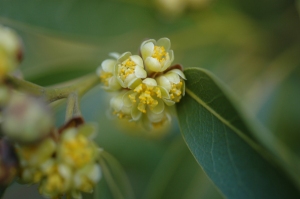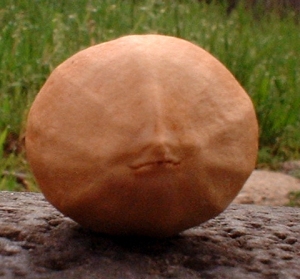NOTE: Bay nuts must be properly roasted to be edible to humans. In spite of our best efforts to the contrary, we still commonly encounter people who are not roasting their bay nuts properly. Most commonly, the nuts are not dried before roasting. The second most common problem is roasting too cool. The toxicity of unroasted bay nuts is unknown, but they are probably not good for you. A tickling irritation in the back of the throat, almost like a burning sensation, is indicative of inadequate roasting. Please read and follow directions.)
Bay nut season is starting here in Northern California and it appears to be a good year. They should be raining down from trees up and down the coast for the next month or more. The season varies year to year. Sometimes it will extend into late November or even later. Ripening times also vary among individual trees with some dropping early and some later on. Here are some tips to increase your success and enjoyment with baynuts this year and for years to come! See this article on the Paleotechnics website for a more in-depth treatment of bay nuts and Bay trees.
*Harvest the nuts in a timely fashion. You don’t want them to either mold, or to start undergoing the physiological changes that happen when they begin sprouting. It’s best to harvest the nuts before the husks are very dried or very rotten. It is easiest to husk them when the outer coating is soft, but not mushy. They are ripe when they begin to drop naturally from the tree. If the husks are too firm and difficult to remove, let them sit around and ripen for a day or three.
* don’t put off Husking the nuts: When they are soft enough, husk them.
* Rinse the nuts in several changes of water briefly before drying.
* Dry soon after harvesting. The nuts are easy to dry and may do fine in a warm well ventilated room. If possible though, keep them near a heat source like a heater or woodstove. If the sun is out, put them on the dash board of a car with the windows just cracked or simply out in the sun on trays during the day, bringing them in at night. When fully dry, the nut inside the shell will be somewhat hard and brittle, not rubbery or flexible.
* Store dry nuts in the shells.
* Always dry the nuts before roasting! Roasting the green nuts is a common mistake, it doesn’t work.
* Roast the nuts in the shells. They can be roasted out of the shell, but our experience is that they roast more evenly in the shell.
* Roast quickly, stirring often: Roast at 425 to 475 degrees Fahrenheit. Stir the nuts every 2 to 3 minutes without fail for about 20 minutes so that they roast evenly. Set a timer so that you don’t forget. If the oven heat is at all uneven, as many ovens are, turn the pan 180 degrees a few times during roasting. (Edit: We’ve been using a popcorn popper to roast lately. Seems to be working very well. See this post.)
* Don’t roast more than you can use soon, and keep the roasted nuts sealed in a small jar or a plastic bag until consumed. They go stale quickly and are best eaten immediately after roasting when they are at their tastiest. Traditional use seems to have been mostly roasted in hot ashes around the fire for fairly immediate consumption.
* Roast them how you like them. As long as they are roasted enough to get rid of the strongly flavored volatile oils that tickle and irritate the throat, you can roast the nuts as dark or light as you like. The color can range from a light brown (the color of coffee with a little cream) to very dark brown. Take some nuts out early and leave others in the oven a little longer to figure out what your preference is.
* Don’t eat too many at once! while tolerance varies, bay nuts do contain a stimulant and can totally wig some people out!
A few additional points:
* Bay nuts are one of the few foods that are high in the rare fat lauric acid, also found in coconut oil and ascribed numerous health benefits.
* The flesh of bay nut husks are edible when ripe. The upper (stem) end of the nut is the best part. The flesh is similar to avocado, to which they are related. It is more of a nibble than a significant food though.
* The fat in bay nuts is very stable being almost completely saturated, so the un-roasted nuts can keep for years.
* Roasted bay nuts make awesome bait for trapping mice and packrats, who can smell them from a long way off and seem to find them irresistible.
Related post: Roasting Bay Nuts in a Popcorn Popper






madeoftinyboxes
/ November 6, 2012the last point is no joke. i always wonder what happens to the ones that get the bait and escape the trap though. its like eating a bay nut half the size of your head. they might end up maniacally munching away at our green house at ten times the speed.
feralzach
/ December 31, 2012as always, great info – thank you!!!
Matt Stone
/ November 16, 2013Love these things. Just tried them for the first time thanks to Steven. I describe them as “the most disgusting irresistible thing in the universe.” It tastes most similar to crunching on roasted coffee beans. But I can’t freaking stop eating them haha.
Stevene
/ November 17, 2013Yep, bay nut pushers. The first one’s free…
Nancy
/ December 20, 2013What animals eat bay nuts? Do squirrels like them? How about porcupines? I just collected some and want to deliver them to an animal rescue group that was collecting acorns, etc. for animals that are in rehabilitation…
Stevene
/ December 20, 2013I’m not entirely sure, but I know squirrels and mice eat them. My chickens also love them! I always throw them the ones that I crack open to check how dry they are, and they fight over them. As far as other birds, I haven’t figured it out yet. some animals are eating the hulls, especially the top part. Rodents seem to eat those too. I’m just not sure for the most part, who is eating the hulls, or the nuts, or both. It has become a point of interest to me though, so I hope to observe close enough to find out more. If you can’t find a rescued animal the eats them, maybe you can roast them, eat them and then volunteer at the animal shelter with all the energy you’ll have! either way, they’ll need to be dried if they are to keep more than a month or so.
nimmolo
/ July 20, 2015Hey Stevene,
Have you ever tried fermenting the fruit in a dense pile before husking, the way the farmers do for cacao? They also turn these fermenting cacao piles pretty frequently, sometimes they use a cascade of tumbling bins to make it easier.
Like you I’ve always immediately husked, I’ve done it that way for five years. But now as I’m reading more about cacao and traditional coffee harvesting, I notice that fermentation is a key step in mellowing the flavors of these seeds. (It also improves digestibility for most seeds and legumes, it seems like.)
But yes, they get moldy pretty quickly. I’m just wondering if you distinctly remember this spoiling the kernel as well as the fruit, or if it’s just disgusting. I can’t remember myself, and i’m thinking to try a side project of fermenting this year, with a part of the nuts.
Stevene
/ July 20, 2015I have thought of it. Pretty much the same thoughts, but I’ve never tried it. They are seriously nasty when they mold, but it seems like a worthwhile experiment. The seed is so isolated in the shell that it seems like they would be unaffected by fermentation of the husk. After all, the husk naturally rots off with the nut still intact for sprouting. Maybe shelling the green nuts first, followed by some kind of short fermentation. Not sure how you’d do that though. I look forward to hearing any results if you try it!
nimmolo
/ July 20, 2015i will do and report back.
nuts obviously not ripe here in east bay, but they seem to be coming in. last year there were very very few.
Stevene
/ July 20, 2015I think the season varies from place to place, as well in larger regions. We don’t get good years that often, and very good years are pretty far between. But there are there are some trees that will bear more consistently. The best spot I go to is deep mountain alluvial soil along a stream where the trees can afford to bear every year if the bloom period is reasonable. Hard to find those areas where you can actually go harvest though.
David R
/ November 19, 2015Stevene
This year seems to be a good one in Sonoma County. I’ve found a few pounds in just 30 minutes of walking.
Stevene
/ November 19, 2015That’s good to know. I haven’t been out much up here yet, but I know our immediately local trees don’t seem to have much.
Palika
/ December 31, 2015Would you kindly add this clarifications to the great article above – 1. how long drying time is? And if you keep dried nuts before roasting them, should they be refrigerated or frozen? thank you so much!
Stevene
/ January 1, 2016They dry pretty fast, but it depends on how warm it is. At least a week under most conditions. You can dry them fast in the oven at very low temperature.
They oils in baynuts, being almost all highly saturated, seem to be extremely stable. I do not freeze or refrigerate them.